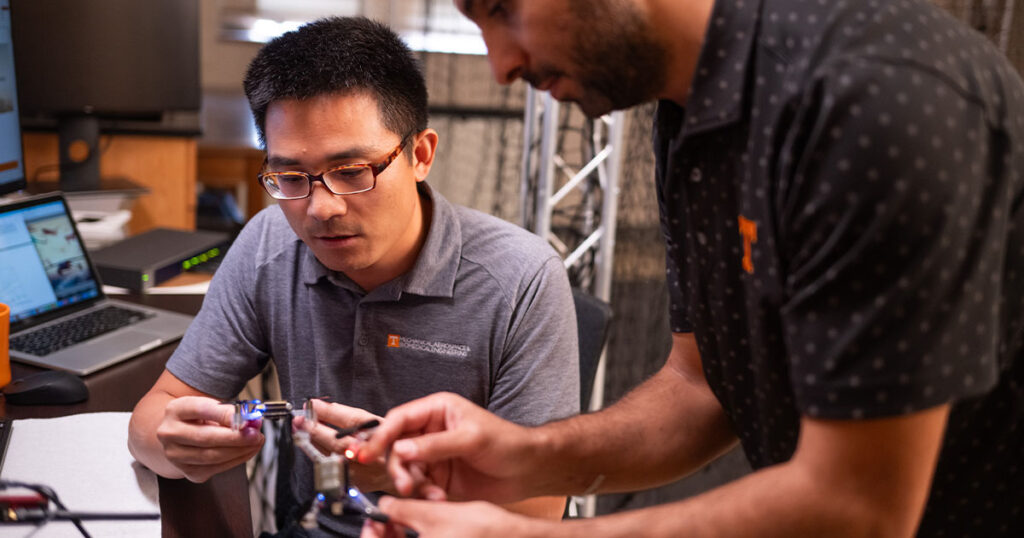While sitting in urban traffic for hours, drivers may daydream about launching into the air and soaring above the congestion.
Associate Professor Zhenbo Wang, of the Department of Mechanical, Aerospace, and Biomedical Engineering, is working to make this dream a reality.
“There is a growing need for innovative solutions to address urban congestion and the environmental impact of current transportation systems,” Wang said. “Advanced air mobility (AAM) systems offer a revolutionary approach to overcoming these challenges by providing a new dimension of mobility.”
Other potential benefits of AAM systems include the potential to use existing land-based infrastructure. Many of the aircraft under development are capable of vertical takeoff and landing, so currently underutilized spaces like the top levels of raised parking structures could be converted to landing pads (vertiports).
AAM systems would utilize a variety of aircraft to meet military, commercial, and civilian needs. While some of these aircraft could be piloted by humans, Wang is most interested in how the autonomous crafts would handle the dynamic environment of an airborne highway.
Wang’s lab has developed a simulated airway system in which aircraft would navigate multiple layers of ‘roads’ above a city, complete with interchanges dictating the flow of craft between major routes. To safely merge or navigate intersections, autonomous aircraft would need to accurately evaluate the positions and velocities of other crafts in real time.
“My approach to AAM focuses on developing a novel airway system coupled with adaptive operational rules and control schemes,” Wang said. “This approach is unique in its emphasis on scalability and adaptability based on real-time factors like travel demand, vertiport distribution, and environmental footprint.”
Last year, with funding from his National Science Foundation Faculty Early Career Development (CAREER) award, Wang was able to establish a laboratory space where he and his students can test their proposed navigational network and drone capabilities.
Integrating Physical and Digital, Terrestrial and Aerial Worlds
One of the challenges with implementing AAM systems is that they will require integrated physical and digital infrastructure. Physically, vertiports need to be located in a way that allows them to be utilized effectively while minimizing noise pollution and environmental impact. Meanwhile, safe and efficient air traffic management will require control centers and autonomous vehicles to dynamically adjust to real-time traffic demand and changing environmental conditions.
Fortunately, as with the physical needs of AAM, Wang thinks it will be possible to expand AAM systems from within existing control systems.
“Digital infrastructure, such as communication networks and data-sharing platforms, can also be expanded and adapted to support real-time monitoring and control of AAM operations,” he said. “This hybrid approach ensures a smoother transition to AAM without the need for entirely new infrastructure from the ground up.”
Advanced Air Mobility on a Tiny Scale
To put his AAM theories to the test, Wang recently expanded his simulations to three dimensions and incorporated a new physical space in his laboratory: a 1,000-square foot, netted area where he and his students can run a wide range of drone flight experiments under controlled conditions.
They use two types of small, open-source drones loaded with a hybrid data-driven control system that Wang designed to balance centralized guidance and the drones’ ability to autonomously react to real-time conditions in a distributed fashion.
“One of the key challenges was creating an environment that allows for the testing of novel control schemes and airspace management strategies in a simulated urban setting,” Wang said. “So far, we have successfully run up to five drones simultaneously, validating some of the control algorithms under development in both aerial intersection and merging scenarios.”
Managing AAM vehicles through intersections that could result in collisions, in real-time, sounded like a tall order. So far, though, Wang has been pleasantly surprised with how well his system has adapted to such challenging mission scenarios while maintaining safety and performance.
“These experiments have provided critical insights into the scalability of our proposed approaches, and they would not have been possible without this dedicated aerial drone testing platform we’ve developed,” he said. “This is a crucial step forward, offering a controlled environment to push the boundaries of what’s possible in AAM. I’m excited about the potential outcomes of this project and look forward to sharing more findings with the community.”
Contact
Izzie Gall (865-974-7203, egall4@utk.edu)
